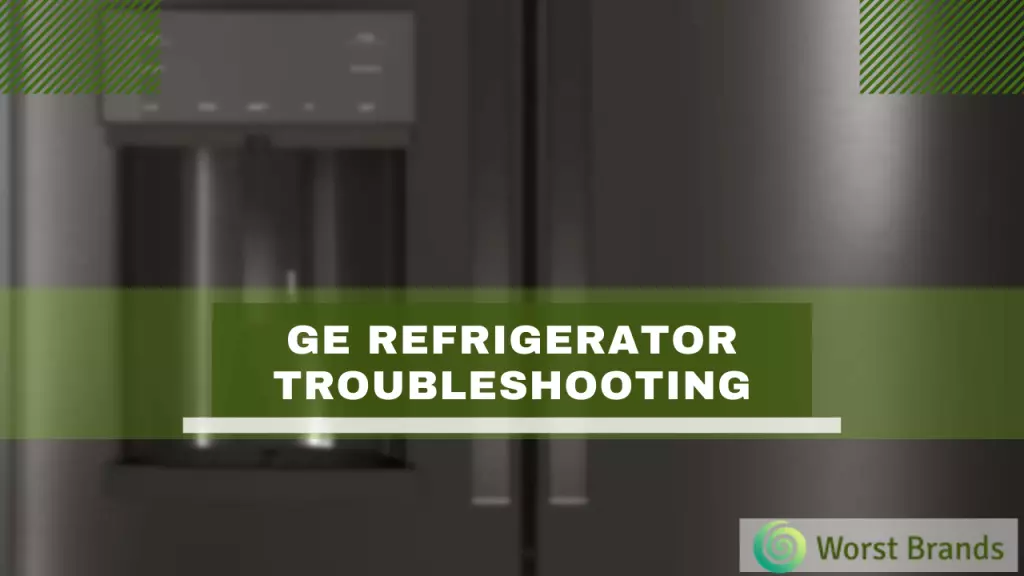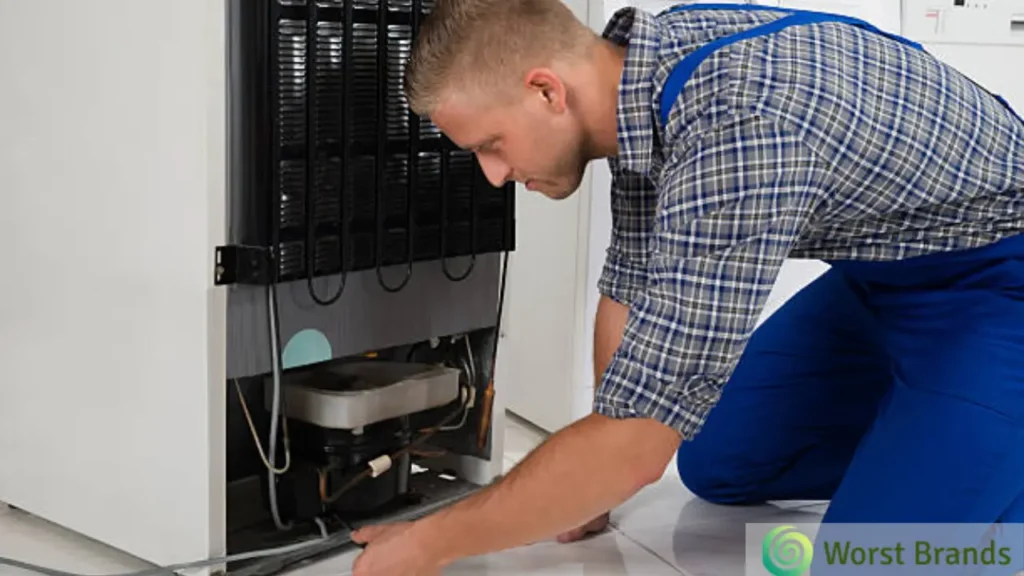
We all know the feeling of not knowing what to do when our refrigerator stops working.
With so many buttons, it can be difficult to determine what the issue is, making the whole process of troubleshooting frustrating.
Having a broken GE refrigerator is no way to live, so you must get your fridge fixed as soon as possible! No one wants to be forced into eating frozen pizzas or soggy leftovers.
Common GE refrigerator problems include power supply issues, water condensation, ice maker malfunctions, door issues, unusual noises, and a few others.
So, we have created this GE refrigerator troubleshooting guide for you with helpful instructions on how to repair your refrigerator at home. Continue reading to learn about all of the most frequent GE refrigerator issues!
However, if you are in the market for a new fridge, be sure to first review the list of refrigerator brands to avoid.
Table of Contents
- 17 GE Refrigerator Troubleshooting and Problems
- 1. Power Supply Issue:
- 2. Water Condensation Issue:
- 3. GE Fridge Not Making Ice:
- 4. GE Fridge Freezer Doesn’t Work:
- 5. Freezer Door Issues:
- 6. Food Preservation Problem:
- 7. GE Refrigerator Won’t Start:
- 8. GE Refrigerator Water Dispenser Not Working:
- 9. GE Refrigerator Not Defrosting:
- 10. Water Leaks:
- 11. GE Fridge Makes No Sound:
- 12. GE Fridge Makes Loud Noises:
- 13. GE Fridge Makes Too Much Ice:
- 14. Faulty Temperature Sensor:
- 15. Faulty Fan Motor:
- 16. Water Pump Issue:
- 17. GE Refrigerator Making Loud Humming Noise:
- GE Refrigerator Repair Tips and Tricks That May Save Your Appliance & Money
- Why Does My Refrigerator Leak Water?
- What’s causing your fridge to leak?
- Is it the fridge’s door seal?
- Final Words:
- Steven Settles
17 GE Refrigerator Troubleshooting and Problems
Check out the most common GE refrigerator problems with their quick fixes before we go into the detailed troubleshooting steps:
| GE Fridge Problems | Quick Fix |
|---|---|
| Power Supply Issues | Check wires, replace if necessary |
| Water Condensation | Improve airflow and ventilation, reduce humidity. |
| Fridge Not Making Ice | Replace faulty control board in ice maker. |
| Freezer Not Working | Check the temperature of coils, replace if necessary. |
| Freezer Door Issues | Repair damaged hinges, replace defective door seals or gaskets. |
| Food Preservation Problem | Ensure proper power supply, check temperature sensor and fan operation. |
| Fridge Won’t Start | Inspect the power unit, clean condenser coils, troubleshoot freezer temperature. |
| Water Dispenser Not Working | Check and replace filter or faulty valve, inspect for leaks. |
| Fridge Not Defrosting | Check temperature settings, defrost timer, and for obstructions. |
| Water Leaks | Replace worn-out condenser coils. |
| Fridge Makes No Sound | Check door gaskets, ice maker connection, defrosting mechanism, and evaporator fan motor. |
| Loud Noises | Inspect for loose internal connections, call the service provider. |
| Excessive Ice Production | Shut off the unit, replace the ice bin. |
| Faulty Temperature Sensor | Replace the temperature sensor. |
| Faulty Fan Motor | Replace the fan motor. |
| Water Pump Issue | Typically requires professional repair due to warranty coverage. |
| Loud Humming Noise | Replace the faulty fan motor or compressor, inspect the door seals and latch mechanism. |
1. Power Supply Issue:
When your fridge is not working properly, check for any loose wires if no electricity is coming into your unit.
The power supply keeps the refrigerator running, and it’s also the main cause of all GE refrigerator problems. So, if the power supply is damaged, you’ll need to change it immediately.
Here are the possible issues that can occur in a refrigerator power supply.
- Leaking or shorting of the circuit. This can damage your appliances, so don’t take chances.
- Defective wiring or insulation. When a wire gets wet or if the insulation gets damaged, it becomes weak and starts acting up.
- Overheating. If your fridge is overheating, it will make a lot of noises, beep, or even smoke. It’s a dangerous situation, so you should immediately contact an electrician to get it fixed.
- Defective compressor. In fact, this is one of the most common issues that occur in a refrigerator. If you notice that your refrigerator doesn’t have any compressor hums, you should call a technician. They will diagnose and fix your problem, so make sure you contact them right away.
2. Water Condensation Issue:
If the water condensation inside the fridge is excessive, it can be due to one of these:
- Too much humidity.
- Insufficient airflow.
- Not enough ventilation.
- Air quality issue.
This can also damage your appliances, so it’s important that you take care of them.
Take the case of the water condensation inside the fridge. It can cause corrosion inside the appliances, leading to serious damage. So, it’s better to have it fixed as soon as possible.

3. GE Fridge Not Making Ice:
What To Do? The most common problem people encounter when their GE refrigerator doesn’t make ice is a faulty control board in the ice maker section of the fridge.
The control board has to be replaced in order to fix this problem. Here is how:
- First, remove the back cover of the refrigerator by pushing it down on the tabs.
- Then remove the panel by unscrewing the two screws that keep it in place.
- Next, lift up the top part of the refrigerator and slide it off.
- After that, disconnect the cables from the control board and remove them from the cabinet.
- Finally, replace a new control board and reconnect the wires.
- Once you have replaced the control board, screw the cover back in place and test the fridge again to see if it’s working properly.
If the problem persists, then the issue might be something else. Here is a complete step-by-step guide on troubleshooting a GE refrigerator not making ice.
4. GE Fridge Freezer Doesn’t Work:
A GE refrigerator freezer that doesn’t work means your freezer isn’t cooling down or heating up the food inside.
The only way to troubleshoot this problem is by opening up the freezer and checking the temperature of the coils.
Inserting a thermometer into the coil is one way to do this. If the temperature of the coils is below 35 degrees, you should consider having the coils replaced.
In this case, a qualified technician would need to replace the coils. This repair takes about two hours to complete.
5. Freezer Door Issues:
The freezer door problem is one of the most prevalent refrigerator issues.
- Damaged hinges. If the hinges are damaged, the door won’t close and open properly. So, make sure you fix them immediately.
- Defective door seals. The door seal ensures that air doesn’t get inside the freezer compartment. When this gets damaged, there will be a lot of noise, and the door will not close properly.
- Damaged door gaskets. If the door gaskets get damaged, the freezer will leak. This is a dangerous situation, so you should contact an electrician.
6. Food Preservation Problem:
The food preservation issue is when the refrigerator doesn’t work as well as it should.
- The main causes of this issue are:
- The power supply is not functioning properly.
- The temperature sensor is not working properly.
- There is too much humidity inside the fridge.
- The fan is not working properly.
If you notice any of these problems, it’s best to immediately call an electrician to fix them.
7. GE Refrigerator Won’t Start:
One of the most common problems with GE fridges is that they will not start at all. This might happen for several reasons:
- The power supply unit may be defective or not connected properly.
- You may need to clean the condenser coils in your refrigerator.
- It’s possible that the ice maker in your GE refrigerator is malfunctioning.
- Your freezer may be too cold.
- Your refrigerator may be experiencing an overload. Or, your refrigerator may have lost its power.
- Lastly, the fan motor may not be working.
All these situations can cause your GE fridge to not start at all.

8. GE Refrigerator Water Dispenser Not Working:
What To Do? If your GE refrigerator water dispenser is not working, check for an issue with the filter or the dispenser itself.
If your filter is clogged or not working properly, it can cause a leak and water to enter the inside of the appliance. You need to replace this part immediately.
The most common issue people encounter when their GE refrigerator doesn’t dispense water is the faulty valve of the water dispenser.
To troubleshoot this problem:
- Press and hold the button in the center of the water dispenser to turn it on.
- Check the faucet for any obstructions if the water isn’t coming out.
- Make sure there are no leaks in the water pipe.
- Replace the water dispenser if it’s broken or worn out.
- If the problem still persists, call an appliance repair professional.
9. GE Refrigerator Not Defrosting:
If you are having issues with your GE fridge not defrosting properly, there are several things to check first:
- Ensure the temperature is set correctly, and the defrost timer is switched on.
- Check if the defrost cycle is on.
- Also, check if your refrigerator has any obstructions that may prevent the defrost cycle from completing.
If none of these things is the problem, try calling GE Appliances Customer Support for a repair.
10. Water Leaks:
Water leaking from your refrigerator’s condenser is one of the most common refrigerator problems.
Faulty coils can cause it in the condenser coil, usually found on the back of your fridge.
In this situation, the coils are worn out and have become brittle. This causes them to break and leak.
The best way to fix this problem is by cleaning and replacing the coils with new ones. You can find replacement coils at home improvement stores.
11. GE Fridge Makes No Sound:
You will notice that your GE refrigerator makes no noise when powered on. You might hear the compressor running, but no other sound is coming from your fridge.
This might indicate that something in your GE refrigerator isn’t operating properly. A quick troubleshooting solution to this problem is as follows:
- Ensure that the door gaskets are installed properly. If they are loose or missing, you will notice a lot of noise when you open or close the fridge.
- Check whether the ice maker is plugged in properly or not. If it is not, then make sure that the unit is working.
- Try and turn on the freezer, if possible, and see whether it is also working. If it is, then there might be a problem with the defrosting mechanism.
- Next, try and open the freezer and see whether you hear any noise from inside. This should be an indication that the evaporator fan motor is working.
- If everything is okay, then you might want to get a professional refrigerator repairman to check your refrigerator.
12. GE Fridge Makes Loud Noises:
This might not be a huge issue, but when you hear noises like banging and creaking from the fridge, you should probably make an appointment with the appliance service provider.
There might be a loose connection inside that needs to be fixed.
13. GE Fridge Makes Too Much Ice:
You might be worried about your kids and their ice cream consumption. But a fridge that makes too much ice is a major problem.
The problem is that the ice maker in the GE refrigerator doesn’t properly freeze the water inside the machine.
This leads to the water dripping out of the ice maker and making ice crystals. This results in the machine making a lot of extra ice, which is the cause of this issue.
To fix this problem, you need to shut off the unit and then remove the ice bin and replace it with a new one.
14. Faulty Temperature Sensor:
The temperature sensor is an electronic component that detects the inside temperature of the fridge.
It helps regulate the temperature within the fridge by changing the compressor speed.
So, a faulty sensor can make your fridge run too hot or cold or even doesn’t work at all. You may change the sensor yourself or get an expert to do it.
Fixing Instructions:
Check out the following steps to replace the temperature sensor:
- Turn off the power switch and disconnect the plug.
- Remove the panel by lifting up the two tabs on the bottom right. At the same time, you can use a screwdriver to remove the screws holding the panel together.
- Once the panel is off, you can remove the temperature sensor by pulling it out from the backside of the fridge.
- Clean the sensor with alcohol to make sure there are no bits of food stuck to it.
- Replace the sensor by pushing it into the backside of the fridge.
15. Faulty Fan Motor:
Fan motors are also electronic components that help circulate air in your refrigerator by turning it on and off. A faulty fan motor can cause noise and may not work at all.
Fixing instructions:
Check out the following steps to replace the fan motor:
- Turn off the power switch and disconnect the plug.
- Open the refrigerator door and locate the fan motor. The fan should spin in a clockwise direction.
- Remove the four screws that hold the refrigerator’s fan to the frame.
- Carefully remove the fan from the frame.
- Unclip the fan wires from the fan’s socket by removing the four small plastic tabs. – Remove the fan motor cover (it is secured with two screws).
- Connect the new fan motor using the four provided screws.
- Replace the fan motor cover and tighten it using the provided screws.
- Plug the power switch back on and test the fan motor. If the fan does not run, replace the fan motor again.
16. Water Pump Issue:
A water pump is a part of your refrigerator that uses water to keep it cool.
It removes the heat from the compressor to keep your fridge’s internal temperature low.
If your refrigerator has a water pump issue, you must contact a professional.
How To Repair It At Home? Since a water pump is a component that is usually covered under warranty, it will cost you a lot if you attempt to fix it yourself..

17. GE Refrigerator Making Loud Humming Noise:
The sound of a humming refrigerator is annoying for everyone. A refrigerator that makes a loud humming noise is most likely having issues with its compressor or the fan motor.
Fixing Instructions:
If the humming noise is constant and there is no sign of electrical current flowing in the fan motor, then this indicates the fan motor is faulty. The fan motor should be replaced with a new one.
If you still hear the humming noise after replacing the fan motor, then you will have to replace the compressor.
The compressor will also make a humming noise caused by a sticky door seal or faulty door latch mechanism.
Well, these are the most frequent problems that you may encounter in your GE refrigerator.
Related: LG vs GE Refrigerators
GE Refrigerator Repair Tips and Tricks That May Save Your Appliance & Money
Are you among many people unsure how to handle a GE refrigerator?
Do you wish there was a way to avoid expensive repairs and keep your refrigerator running as efficiently as possible?
If so, here I will outline some of the most important tips and tricks on keeping your GE refrigerator from breaking down or costing you money. Check out:
- Do NOT open your refrigerator every time you eat something. This can lead to ice buildup and other issues. Instead, only open your fridge when you’re ready to eat. Or better yet, have your food delivered to your door.
- Keep an eye on your freezer temperature. You can set your GE refrigerator to defrost or freeze things on a schedule automatically. But make sure to check the temperature regularly.
- Check your ice maker every month. If you have a multi-level ice maker, this is very crucial. Over time, the ice maker itself can get full of sediment, which can lead to mold and other issues. So go ahead and give your ice maker a once-over each month. It only takes a few minutes.
- Check for seal cracks and crevices in your refrigerator. Cracks and crevices can let air in. And let cold air out. Both of which can lead to refrigerator problems. So make sure to wipe down your refrigerator door gaskets every month. You can use a simple cotton ball. Or, you may also use a vinegar-to-water solution (1 part vinegar to 5 parts water).
- Keep an eye out for strange noises. A strange noise coming from your refrigerator could be a sign of a major issue (like a compressor failure). So go ahead and take a quick listen to your refrigerator. You can do this by placing your ear next to the refrigerator. And listening for strange sounds. Or by using an app like Refrigerator Finder.
Why Does My Refrigerator Leak Water?
One of the most common complaints people have is their refrigerator leaking water. This can be very frustrating and not to mention expensive.
Most people don’t know what to do when encountering this problem, but there are some steps you can take to fix it.
What’s causing your fridge to leak?
Several things could cause your fridge to leak water, but the two most common reasons are a faulty seal, or the door gasket is worn out.
These defects will lead to water leaks, which can cause mold growth and other health concerns if left unchecked. For these reasons, you must address this problem before it gets worse.
The first step is inspecting for any visible signs of a leak coming from behind or under the fridge.
For instance: wet floors, a leaky faucet, or puddles on the floor. If no signs of a leak are found, you may need to inspect for other potential sources of water leaks.
Is it the fridge’s door seal?
Another common cause of refrigerator leaks is a leaky door seal. A refrigerator door seal can become weak and deteriorate over time.
This leads to water leaking into the interior of the refrigerator. If you find any signs of leakage from under your refrigerator, this could cause your leak.
What’s the best way to fix it? If a loose or damaged door seal causes a problem, replacing the seal with a new one is best.
When replacing the door seal, get the right one for your model. You don’t want to get a seal that isn’t compatible with your model.
The seal should be attached using screws and adhesive tape or glue.
Final Words:
Well, there you have it, a list of the most common problems you may encounter with your GE refrigerator Troubleshooting guide.
Now, if you notice any of the issues on this list, try to address them before they get too bad.
Hopefully, this list will help you identify what’s causing your fridge to break down and lead you to troubleshoot the problem easily.
If you still haven’t figured out what’s wrong with your refrigerator, leave a comment below.

Steven Settles is an ISCET-certified master in appliance repair. He has aced the National Appliance Service Technician Certification Exam, showcasing his exceptional diagnostic and repair skills. With an in-depth understanding of the latest repair technologies and a keen eye on evolving industry standards, Steven is a go-to expert for any appliance issue.
I ordered a GE energy star model number GDE 21EYKFS
I was sent a model number GDE21EYKERFS
I can’t locate any information about this 30 inch 21 ft.³ refrigerator freezer. It’s not the one I ordered and apparently it’s discontinued and I can’t find one single piece of information on the Internet about it? I’ve had it for one week and noticed the difference between what I ordered and what I got. There’s no way I can track the history it’s like it never existed. Strange
we have a GE model PFE28KMKNES and lately when we try to get ice or water from the dispenser it won’t’ stop the process, it keeps on dispensing either ice or water until we open the door to stop it. Any suggestions?
I have a GE Profile refrigerator. I cannot set the temperature. The lights are flashing on 0 and when I open the door the lights inside are flashing also. What should I do? I don’t know how to reset it.
Thanks for your help.
I have GE frig model gse26ggebb It wont depence ice or water. Ice maker still makes ice. Some times it flashes 0 across temperature readings Unpluged it once and it stopped. Still get temperature readings. Is this circuit board problem?
i have a GE side by side and just completed a repair on the ice door flapper and the solenoid due to a slow dripping of water into the seat where the ice and water lands. I’m still seeing droplets of water dripping down from the flapper door. looking into the opening, i see condensation on the outside of the flapper door. it doesn’t seem to be leakinf from the rubber seal, please advise. ,
GE fridge model gls25jfxn lb
Fridge not cooling, no power to control panel, what is the wrong?
Hi,
The issue is most likely either frost-clogged evaporator coils or a jammed or damaged evaporator fan if you can hear the compressor operating but the refrigerator isn’t cooling. When they begin to malfunction, evaporator fans often shriek or chirp.
I have a newer side by side. GSS25SLSRCSS. I change the water filter XWFE when I put the new filter in And try to purge the system I get an err message on the display. It will not reset? I have tried everything. The filter in exactly like the one I took out? Please Help… Johnny
Hi Johnny,
In order to get rid of this err message, you can press and hold the power button for a while or you can just wait for few seconds and see that it would disappear.
If the problem persists, then please contact the customer service phone number provided in your user manual.